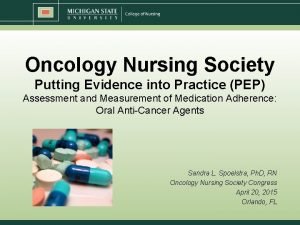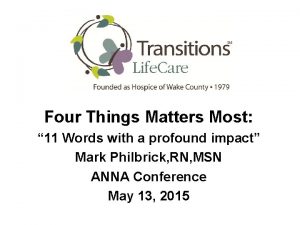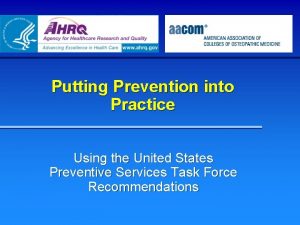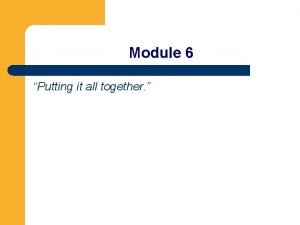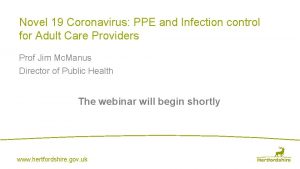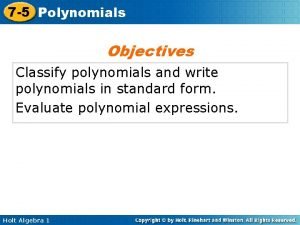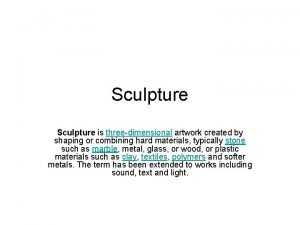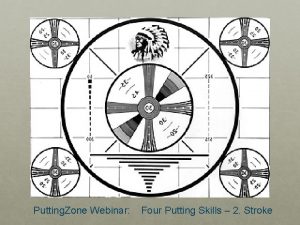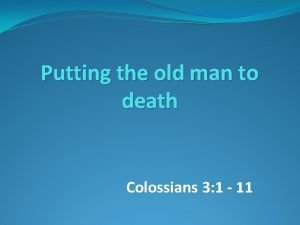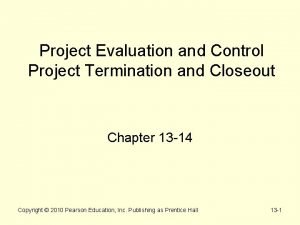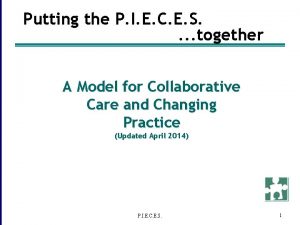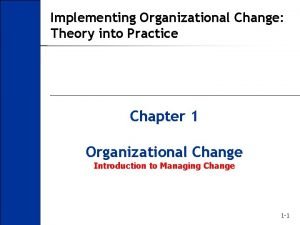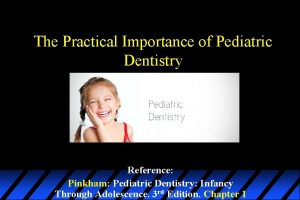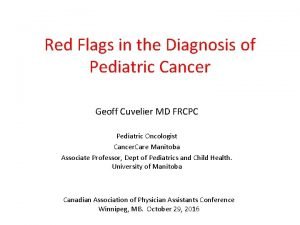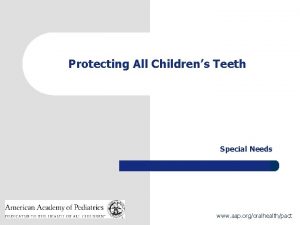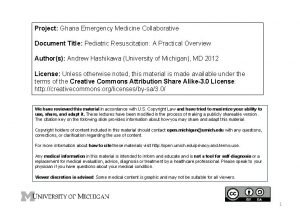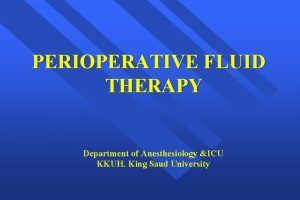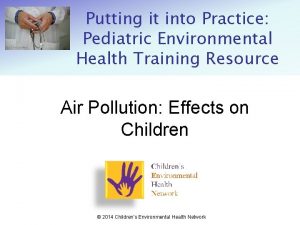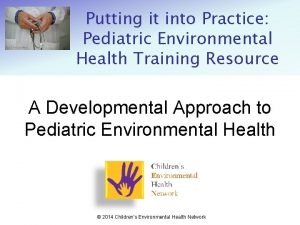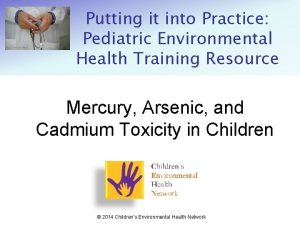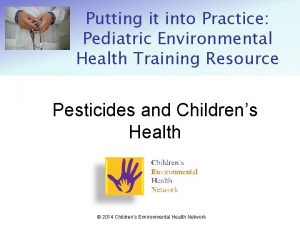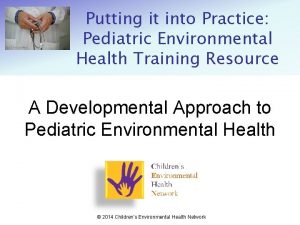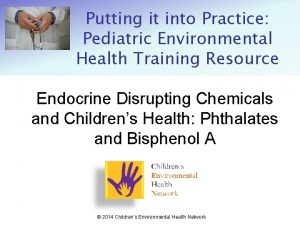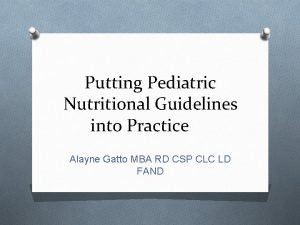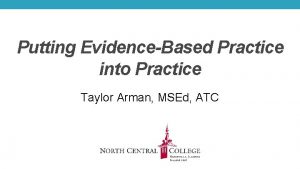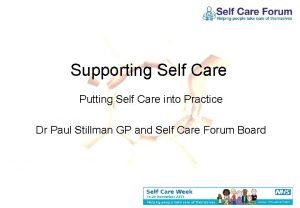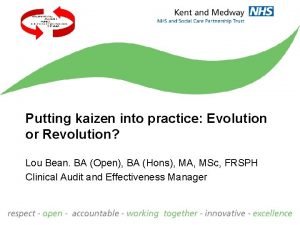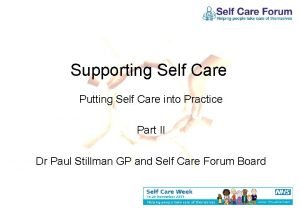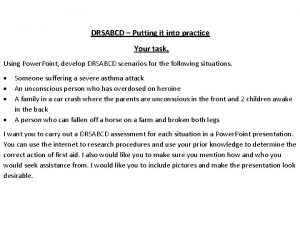Alex E ProimosFlickr Putting it into Practice Pediatric










































- Slides: 42

Alex E. Proimos/Flickr Putting it into Practice: Pediatric Environmental Health Training Resource Mercury, Arsenic, and Cadmium Toxicity in Children © 2014 Children’s Environmental Health Network

Author This presentation was developed by: Shahram Yazdani, MD UCLA David Geffen School of Medicine “Putting it into Practice: Pediatric Environmental Health Training Resource” made possible by support from the W. K. Kellogg Foundation Image in slide #1 courtesy of Alex E. Proimos/Flickr, used under Creative Commons Attribution-Non. Commercial 4. 0 International License: http: //creativecommons. org/licenses/by-nc/4. 0/legalcode

Mercury (Hg) • Naturally occurring heavy metal (Hg) • Shiny silvery-white liquid at 25 °C • Has many industrial uses • Found in three forms: - Elemental: pure mercury, silvery white liquid - Organic: methylmercury, ethylmercury - Inorganic: mercuric chloride, mercuric oxide

Epidemiology • Mass exposure: – Minamata Bay in Japan (1959): contaminated fish – Iraq (1970’s): fungicide-treated grain • Sporadic exposure: – Contaminated fish: (all fish have some mercury) – Breast milk of exposed mothers – Vapor inhalation: broken fluorescent bulbs, thermometers – Transdermal: contaminated diapers, skin bleach

Sources of Exposure • Elemental (Hg) – Production of/Broken fluorescent light bulbs, manometers, thermometers, batteries – Small scale gold mining outside the US and Europe – Contaminated water and food source (i. e. contaminated soil) – Folk remedies or religious ceremonies (Santería)

Sources of Exposure • Inorganic (Hg): – Folk medicine such as Ayurvedic medicine (from India) – Folk skin lightening creams – Mercuric cyanide & other compounds: Extremely rare in children.

Sources of Exposure • Organic (Hg): -Methylmercury: Found in seafood, particularly larger, longer living animals 1 Figure: EPA -Thiomersal (Ethyl mercury): Mostly discontinued; Some multi-dose vaccines may contain the preservative 2, 3 1 -US EPA; 2001. publication No EPA-823 -R-01 -001. http: //www. waterboards. ca. gov/water_issues/programs/tmdl/records/region_1/2003/ref 1799. pdf. 2 - AAP, Committee on Infectious Diseases, Committee on Environmental Health. Pediatrics. 1999. 3 -AAFP, AAP, Advisory Committee on Immunization Practices, Public Health Service. MMWR, 2000.

Clinical signs and symptoms ( Prenatal exposure) • High dose exposure: – Mental retardation – Cerebral palsy – Cerebellar ataxia and reflex anomaly – Failure to thrive • Lower dosage from fish may cause neurocognitive deficit, but controversial. Bose-O’Reilly, S. et al, Curr Probl Pediatr Adolesc Health Care, 2010.

Clinical Signs and Symptoms (Chronic Exposure) • Neurologic symptoms (in the order of progression from low to high dose exposure) – Paresthesia leading to ataxia – Generalized weakness – Ptosis, visual impairment – Hearing impairment and aphasia – Tremor mercurialis and muscle spasm – Cachexia – Incontinence – Stupor and coma Mergler D, et al. Ambio, 2007.

Clinical Signs and Symptoms (Chronic Exposure) • Dermatotoxic reactions: range from chronic dermatosis to Acrodynia. – Seen in both organic and inorganic poisoning – Acrodynia (AKA Pink’s Disease) includes triad of: • Skin: exanthema, edematous erythematous painful desquamating hands and feet. • Neurologic: paresthesia, irritability, photophobia, weakness • Hypertension Harada M. Crit Rev Toxicol, 1995. Gotelli CA, et al. Science, 1985.

Acrodynia

Clinical Signs and Symptoms (Chronic Exposure) • Other organ damages include: – Neurodevelopmental: pre- and postnatal exposure – Nephrotoxic: proximal tubules with inorganic Hg – Teratogenic: mostly inorganic and methyl mercury – Cardiac: decreased Heart rate variability and hypertension – Carcinogenic: methylmercury associated with leukemia in adults Clarkson TW, et al. N Engl J Med, 2003. Bose-O’Reilly, S. et al, Curr Probl Pediatr Adolesc Health Care, 2010. Yorifuji T, et al. Int Arch Occup Environ Health 2007; 80: 679 -88.

Clinical Signs and Symptoms (Acute Exposure) • Usually due to vapor inhalation from broken fluorescent bulbs • Cough • Dyspnea • Longer-lasting effects similar to chronic poisoning • Inflammation of gums and oral mucosa • Proteinuria

Diagnosis • History of possible exposure and physical findings • Laboratory confirmation – 24 -hour Urine testing: best suited for elemental or inorganic mercury (can use Hg/Cr ratio in kids) – Blood testing: for organic mercury; place whole blood in K-EDTA tubes – Hair: Most useful to quantify Me. Hg exposure for research purposes. Not useful in the clinical setting WHO, 1996. Biological Monitoring of Chemical Exposure in the Workplace, Vol. 1. World Health Organization, Geneva. UN Envir Program, WHO, International Atomic Energy Agency. The determination of methylmercury, total mercury and total selenium in human hair. In: Reference Methods for Marine Pollution Studies, 1987. AAP Council on Environmental Health. [Mercury]. In: Etzel RA, Ed. Pediatric Environmental Health, 3 rd edition, 2012.

Diagnosis Guidance levels of mercury concentrations in blood , urine, and hair Human biomonitoring threshold limits Hg in blood (µg/L) Hg in urine (µg/L Crea) Hg in hair (µg/kg/d ) HBM I (alert value) 5 7 5 __ HBM II (action level) 15 25 20 __ US EPA bench mark __ __ __ 0. 1 Commission on Human Biomonitoring of the Federal Environmental Agency. [Monograph Mercury—reference values and human bio- monitoring values]. Bundesgesundheitsblatt, 1999.

Treatment Chelation: primary recommended treatment • DMSA (Succimer): – First line treatment in the US for severe organic mercury poisoning. – No evidence of reduced methylmercury in human brain. 1 – Can be used as prophylaxis for metallic mercury exposure in children 2 – Does not remove inorganic mercury from the body and brain • Dimercaprol (British anti lewisite(BAL in oil): – Effective in treating inorganic mercury poisoning – Should not be used in cases of methylmercury poisoning since it may increase the amount of mercury in the brain. – Available as intramuscular injection (painful)3 1 -Louwerse, E. S. , et al. 1995. Int. Arch. Occup. Environ. Health, 1995. 2 -Forman, J. , et al. Environ. Health Perspect, 2000. 3 -Goyer, R. A. , Clarkson, T. W. Toxic effects of metals. In: Klaassen, C. D. , Ed. , Casarett & Doull’s Toxicology: The Basic of Poisons, 6 th Ed, 2001.

Treatment Chelation: primary recommended treatment • D-Penicillamine: – Reduces blood Methylmercury 1 – High side effect profile – Reports of treatment failure in children with Acrodynia 2 • DMPS ( 2, 3 -dimercapto-1 - propane sulfonic acid ): – Recommended as the first-line treatment of inorganic mercury by WHO 3, 4 – Not FDA approved – Does not remove inorganic mercury from the body and brain 1 -Clarkson, T. W. , et al. 1981. J. Pharmacol. Exp. Ther, 1981. 2 -Karagol, U. et al. Eur. J. Pediatr, 1988. 3 - WHO. JAMA , 1991. 4 -Campbell, J. R. et al. JAMA, 1986.

Prevention • Prevention is both effective and practical • Never vacuum spilled mercury/broken fluorescent light bulbs • Pregnant/lactating mothers and children should: – Eat less than 12 oz/week of lower mercury fish (sardines, salmon, pollock, catfish) – Limit albacore tuna to 6 oz per week – Avoid swordfish, shark, king mackerel, or tilefish – Avoid whale blubber (used in some countries for cooking) – Avoid skin-lightening cream, industrial exposure or folk remedies http: //www. fda. gov/food/resourcesforyou/consumers/ucm 110591. htm

Arsenic (As) • Extremely abundant in nature in the earth’s crust • Found in the southwestern states, eastern Michigan and parts of New England • Found in three forms: – Elemental – Organic – Inorganic • Children are susceptible to its antimetabolite and carcinogenic effect

Arsenic • Found in three major forms: – Elemental • Used as alloy and semiconductor industry – Organic • Organic arsenical pesticides are very toxic • Naturally formed organic arsenic is less toxic (in fish) – Inorganic • Trivalent (arsenite) is far more toxic and frequently used in the industry than arsenate. • Pentavalent (arsenate): mostly used as insecticide and poisons

Epidemiology • • • Mostly absorbed through ingestion May be transported through placenta Not absorbable through intact skin Less common in developed countries Continues to cause water poisoning in less developed countries • Elemental and inorganic arsenic are more toxic than its organic form

Sources of Exposure • Well water: Levels may vary with earthquakes causing increased exposure of arsenic veins • Anthropogenic (industrial, agricultural) and natural runoffs • Incinerators • Pressure-treated wood (copper chromium arsenate): found in many residential and kids’ play areas (jungle gyms) despite FDA ban for residential wood treatment since 2003 • Pesticides: still found despite their ban in U. S. • Rice: amounts to a minor factor in western diet • Fish: less toxic organic As

Clinical signs and symptoms (Acute) • High dose acute poisoning (>3 -5 mg/kg of elemental As) – Emesis within 30 minutes – Rapid progression to hematemesis – Abdominal cramping – Diarrhea (3% present as bloody/rice water) – Mees’ lines: white transverse creases across the nails – Multi-organ failure (brain, kidney, liver) – Most die from shock or hypovolemia Xu Y, et al. Toxicological Sciences, 2008.

Mees’ lines Seen both in acute and chronic arsenic poisoning

Clinical signs and symptoms (Acute) • Lower dose acute poisoning (<3 mg/kg of elemental As) – – – – – A more protracted course Facial edema and transient flushing Intertriginous erythema/maculopapular rash Hypotension T-wave inversion Congestive heart failure shock Pulmonary edema Sensorimotor peripheral axonal neuropathy Other: proteinuria, hematuria, bone marrow suppression, rhabdomyolysis and conjunctivitis AAP Council on Environmental health. Chapter 22: Arsenic. In: Etzel, RA, Ed. Pediatric Environmental Heath, 3 rd Edition, 2012.

Clinical signs and symptoms (Chronic) • Chronic exposure in children (can present with a wide range of symptoms): – Low-grade bone marrow depression – Generalized fatigue – Severe skin changes: include Mees’ lines, eczematoid eruption, hyperkeratosis, melanosis – Liver dysfunction – Neurologic dysfunction – Cancer: risk in children not clear; mostly adult onset, skin, lungs, bladder, liver

Chronic Arsenic skin changes Hyperkeratosis Hypermelanosis of the chest

Clinical signs and symptoms • Chronic exposure in pregnant women: – Spontaneous abortion – Still birth – Low birth weight – Preterm delivery

Diagnosis • Arsenic is mostly excreted through the kidneys • 24 -hour urine test (must be fractionated) • Spot urine is not recommended in children • Fractionation distinguishes highly toxic inorganic AS from the less toxic organic form • If fractionation is not available, patient must avoid seafood for 2 -5 days prior to urine test

Treatment • For significant exposure, chelation is recommended • All treatments should be in consultation with a toxicologist and close observation • D-Penicillamine – 100 mg/kg/d po divided q 6 h x 5 days • Dimercaprol (BAL) – Mild poisoning: 2. 5 mg/kg IM q 6 h x 8 doses, then q 12 h x 2 doses, then q 24 h x 10 doses • Succimer (DMSA) – Approved and dosed based on lead poisoning treatment – 10 mg/kg po q 8 h x 5 days, then q 12 h x 14 days Franzblau A, Lilis R. Arch Environ Health, 1989.

Prevention • Drinking water: test all well water (<10 ppb recommended by WHO) • Avoid As-contaminated water or soil in agriculture (i. e. rice) • Consider the following when kids may be in contact with treated wood (copper chromium arsenate (CCA)) – Never burn or saw treated wood – Avoid old wooden cribs – Seal old wooden jungle gyms and decks every 6 months or annually – Children should avoid hand to mouth contact after accidental contact with CCA treated wood and thoroughly wash their hands ASAP.

Cadmium (Cd) • A heavy metal found in earth’s crust • Natural sources – Rock erosion – Forest fires – Volcanic eruptions • A recent anthropogenic contaminant (19 th century) – Byproduct of zinc production – Mining – Smelting/incineration of waste

Epidemiology • Less of a problem in developed countries • Still a significant burden in developing countries • Mainly absorbed through: – Inhalation of cadmium dust (industrial) – Ingestion of contaminated food – Tobacco smoke inhalation

Sources of Exposure • Animal food sources (if exposed to Cd) – Sea food: oysters, mussels, certain species of fish – Mammalian kidney – Mammalian liver • • Grains from contaminated soil: wheat, rice Root plants: onion, potatoes Jewelry: gold and silver soldering Tobacco smoke

Features of Toxicity • Kidneys: may cause failure • Liver: along with kidneys may comprise 50% of the total body Cd • Lungs: worse with inhalation; affected both in acute and chronic cases • Bone: 3 rd depot of Cd poisoning; mainly chronic poisoning • Half-life of 10 -20 years in the tissue • Cd does not readily cross placenta or bloodbrain barrier

Clinical signs and symptoms (Acute) • Ingestion – Salivation – Emesis and abdominal pain – Painful spasm of the anal sphincter – Vertigo – Loss of consciousness AAP Council on Environmental health. Chapter 24. In: Etzel, RA, Ed. Pediatric Environmental Heath, 3 rd Edition, 2012.

Clinical signs and symptoms (Acute) • Inhalation – Cough – Dry throat – Headache and chills – Muscle weakness – Leg pain – Chest pain – Pulmonary edema – Bronchospasm – Pneumonitis

Clinical signs and symptoms (Chronic) • Kidney damage – Microproteinuria (mild cases) – Nephropathy (severe cases) • Bone pain – Osteomalacia • Lung damage – Restrictive lung changes Friberg L. Acta Med Scand, 1950. Bernanrd A. Indian J Med Res, 2008.

Diagnosis • Blood – Reflects recent exposure – Half-life 75 -128 days – Normal value for non-smoker <1 mg/l, for smoker <5 mg/l • Urine – – 24 -hr urine or Cd/Cr ratio Gold standard measure of toxicity No child standards available Normal <10 mg/g creatinine. Renal damage begins at 2 mg/g creatinine in adults. – Mean Urine [Cd] in 6 -11 y. o. 0. 075 mg/g

Prevention • Prevention is more effective than treatment – Avoid crops grown in contaminated soil or water – EPA maximum contaminant level for Cd is set at 0. 005 mg/L – Limit liver and kidney consumption in children – Avoid second hand smoke – Avoid playing with metal jewelry AAP Council on Environmental health. Chapter 24. In: Etzel, RA, Ed. Pediatric Environmental Heath, 3 rd Edition , 2012.

Treatment • No effective treatment available • Chelation may worsen renal toxicity by mobilizing Cd from other tissues and further exposing the kidneys • Supportive care for renal damage/failure • Large doses of Vitamin D to treat osteomalacia Johri N, et al. Biometals , 2010.

Contact Information Nsedu Obot Witherspoon, MPH Executive Director Children’s Environmental Health Network Email: nobot@cehn. org Phone: 202 -543 -4033 www. cehn. org
 The pricing tripod
The pricing tripod Putting evidence into practice
Putting evidence into practice Putting it into practice
Putting it into practice Putting prevention into practice
Putting prevention into practice Coherent curriculum
Coherent curriculum Putting the enterprise into the enterprise system
Putting the enterprise into the enterprise system Putting the enterprise into the enterprise system
Putting the enterprise into the enterprise system Practice notebook - putting it all together
Practice notebook - putting it all together Putting-out system
Putting-out system What is nasreen putting chocolate on
What is nasreen putting chocolate on When was the loom invented
When was the loom invented Putting-out system
Putting-out system After putting the pieces together what do they look like
After putting the pieces together what do they look like Putting objects in perspective
Putting objects in perspective The order of putting on ppe
The order of putting on ppe Putting it all together motion answer key
Putting it all together motion answer key Ordering fractions with different denominators
Ordering fractions with different denominators Putting people first 2007
Putting people first 2007 Putting-out system
Putting-out system Polynomial standard form
Polynomial standard form Letters put together
Letters put together Sculpture is created by shaping or combining the materials
Sculpture is created by shaping or combining the materials Putting zone
Putting zone Putting to death the old man
Putting to death the old man Putter stance setup
Putter stance setup Package mypackage; class first { /* class body */ }
Package mypackage; class first { /* class body */ } The spatial strategy of organizing your speech
The spatial strategy of organizing your speech Putting on the new man
Putting on the new man Putting two words together
Putting two words together Putting it all together wow
Putting it all together wow Putting it all together
Putting it all together Project evaluation and control
Project evaluation and control Putting the pieces together case study answer key
Putting the pieces together case study answer key Putting things together is called
Putting things together is called Implementing organizational change theory into practice
Implementing organizational change theory into practice Practice assessor feedback examples
Practice assessor feedback examples Unc hematology oncology fellows
Unc hematology oncology fellows Miami pediatric nephrology seminar
Miami pediatric nephrology seminar Definition of pediatric dentistry
Definition of pediatric dentistry Pediatric headache red flags
Pediatric headache red flags Pediatric seizures
Pediatric seizures Pediatric vitals
Pediatric vitals Plasmlyte
Plasmlyte

